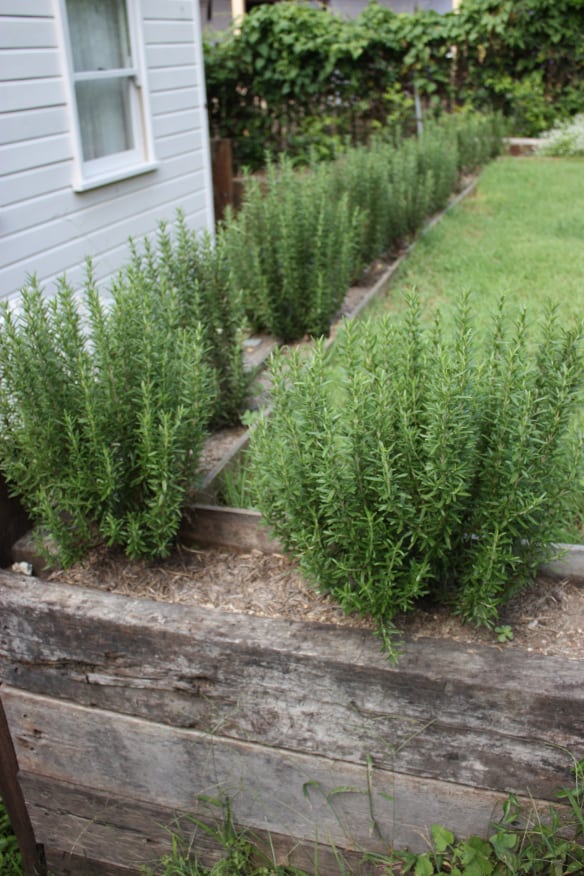Rosemary Basics
Native to the Mediterranean region, Rosemary is a drought-tolerant evergreen shrub and will grow as long as it is in full sun. Rosemary is an attractive form, coming in upright, spreading, and prostrate, with an interesting texture that makes a nice backdrop to lower perennials and annuals. The aromatic leaves are a highly sought-after feature of this plant, and, of course, these leaves can be used in cooking. While Rosemary doesn’t live as long as many Texas shrubs, you can expect several years out of it.
Rosemary shrubs range from 2 to 6 feet tall by 3 to 6 feet wide, depending on the variety. We recommend spacing rosemary 2 to 4 feet in the center apart from each other. While the silvery-green leaves offer year-round color, Rosemary flowers in late winter through April or May with small blue flowers.
Rosemary has two weaknesses. First, it is somewhat tender, suffering damage when temperatures dip below the teens. Second, rosemary is susceptible to root rot, typically from poor drainage and over-watering. To care for your rosemary, once it is established, occasional deep watering is all it needs to survive. You can prune rosemary lightly to shape as desired and feed your rosemary little, if at all.
One great advantage to rosemary is that the aromatic oils this plant produces become a natural insect repellant and critters such as deer and rabbits don’t like the taste, so your rosemary will be left for you to enjoy and add to any culinary dishes you see fit.
How to Plant a Rosemary Hedge

Are you interested in adding rosemary to your landscape? Turn this edible herb into a hedge by following these simple steps:
1. Two to four weeks after the last frost date, choose a spot where the rosemary hedge will receive full sun, at least 6 to 8 hours a day, and an area that drains extremely well. Mix a 2-inch layer of sand on the top 10 to 12 inches of soil at the planting.
2. Use a tiller to break up the heavy soils. Till a 3- to 4-foot wide strip along the ground, going about 18 inches deep.
3. Spread 2 to 3 inches of compost over the planting site with a rake. Mix the compost into the to 10 to 12 inches of soil with the tiller.
4. Dig a hole equal in depth and twice the width of the rosemary plant’s root ball using a shovel. Space the individual holes 12 to 14 inches apart to create a dense hedge and 16 to 18 inches apart for a lighter hedge. Scrape the bottom of each hole with a shovel to make it as flat as possible.
5. While wearing gloves to prevent scrapes and cuts to your hands, grasp the base of the rosemary plant in one hand and the bottom of its pot in the other hand. Tip the plant carefully on its side. Slide the root ball out of the pot. Grasp the bottom of the root ball with both hands and gently massage the bottom roots to slightly spread them out and stimulate growth.
6. Place the rosemary plant upright in the center of the hole and backfill the hole halfway. Tramp the soil down firmly but gently around the sides of the roots. Backfill the remaining space in the hole and tramp the soil down once more. Do not overfill the hole. Plant the rosemary at a depth equal to its previous growing depth. Repeat this process with each plant.
7. Water the soil around the newly planted rosemary bushes using a garden hose, wetting the soil thoroughly. Water the plants once per week, applying approximately one inch of water each time, keeping the soil moist but not soggy. Water when the top one to two inches of soil become dry once the plants are established and begin to produce new growth
Cooking with Rosemary: Garlic and Rosemary Grilled Chicken with Scallions

This recipe and photo are courtesy of Bon Appetite Magazine
Ingredients: 1 3.5-4 lb. chicken, backbone removed Kosher salt and freshly ground pepper 4 sprigs rosemary 2 heads of garlic, halved crosswise 2 bunches red scallions 2 tablespoons olive oil, divided 1 tablespoon onion or chive blossoms (optional).